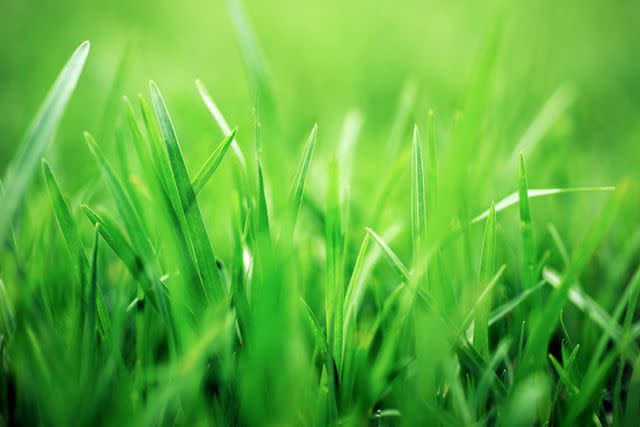The Best Time to Plant Grass Seed for a Greener Lawn
You're looking for "Goldilocks" weather for the greenest lawn.
If your lawn is starting to look a little bare in spots, you're probably wondering if now's the best time to plant grass seed—or if you'll just end up feeding the birds when you scatter the seed. While you can plant grass pretty much year round, there are certain times of year that are more likely to guarantee a greener lawn from all your efforts.
Try these tips to help your lawn thrive, from expert Teri Valenzuela, natural science manager at lawn care company Sunday.
Related: The Best Time to Water Grass for a Greener Lawn—and Less Water Waste

Jason Hosking / Getty Images
Plant Grass Seed When the Weather's Mild
Planting in the heat of summer makes it harder to keep tender young seedlings thriving, so spring and fall are where it's at. "They're like the Goldilocks seasons for grass—not too hot, not too cold," Valenzuela says. "These seasons tend to offer milder temperatures and increased precipitation, making sure your grass seeds don't dry out too quickly. The extra rainfall can also help ensure that they're watered enough to Plus, with added rainfall, new grass seedlings are less likely to miss a vital watering that’s critical to their establishment."
Watch Out for Frost
Freezing temps are the enemy of new grass, so it's best to plant grass seed after frosts have ended in the spring or before they start up in the fall. "Timing is everything!" Valenzuela says. "Aim to seed in the fall before mid-October. Any later, and those young grasses risk facing frosty mornings or freeze, leading to potential bare patches in spring."
Valenzuela also recommends waiting until average daily temperatures are in the 55- to 75-degree range for cool season grasses that you'd use in northern places, or 70- to 90-degree range in the South. (If you live in the middle of the country, you can use either cool-weather or warm-weather grasses, depending on which you'd like.
Choose the Right Type of Grass Seed for Your Lawn
In cooler climates, you want to lean toward cool-season grasses like fescues or Kentucky bluegrass, while warm-season grasses like bermudagrass and St. Augustine flourish in hot temperatures.
You'll also want to think about how you use your yard and the light conditions where your lawn is planted. "If an area of your lawn is predominantly shaded, opt for a shade-tolerant seed," Valenzuela says. If heat and drought are concerning, there’s a grass type that is cultivated to tolerate it. If you have kids and pets running and playing across your yard, select a hardy grass that’s able to withstand more foot traffic."
"Getting this grass seed pairing right is a fundamental step in ensuring your grass seeds stand a good chance of growing from the get-go," she says.
Related: 10 Organic Lawn Care Ideas Without Using Harsh Chemicals
Sow the Grass Seed the Right Way
If you're reseeding a sparse lawn, mow it short first, and rake away trimmings to help the seeds reach the soil. In very bare spots, you should rake or otherwise break up the soil before you sprinkle on the seeds.
Use a rotary spreader to put down the seeds, following the package directions for how thick you seed the lawn. (Putting down too much seeed could make it hard for the lawn to take root, and underseeding will result in a thin, scraggly lawn.) Gently water the seeds, and continue to water any sparse areas once or twice a day until the grass is established.
Give Your Grass Time to Grow
You'll want to baby the grass a bit until those wisps of grass seedlings start to look more like an actual lawn. Stay off newly seeded patches to let the grass grow and keep the soil moist to help it thrive. It may seem counterintuitive, but Valenzuela says that mowing can actually help your grass grow even thicker and stronger—just wait until your new lawn is around four inches long before doing that initial mow of your new grass. "Mowing actually prompts grass to spread across your lawn, filling in your lawn faster." And that can mean that you'll need to do less patching and reseeding next season.
For more Real Simple news, make sure to sign up for our newsletter!
Read the original article on Real Simple.

